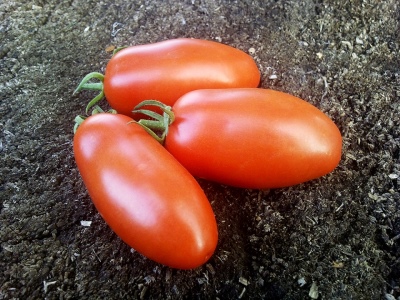
- Authors: Dederko V.N.
- Year of approval: 2014
- Category: grade
- Growth type: indeterminate
- Appointment: fresh consumption, for pickling and preserving
- Ripening period: mid-early
- Growing conditions: for open ground, for film greenhouses, for closed ground
- Marketability: Yes
- Marketable fruit yield,%: 97,3%
- Bush size: tall
A good option for a mid-early tomato variety on the site is Scarlet Mustang. It gives good yields and does not require much attention.
Description of the variety
Indeterminate variety, suitable for open and closed ground and film greenhouses. Scarlet mustang is a tall shrub that grows up to 150-180 cm. It is a variety with a simple inflorescence.
The main qualities of the fruit
The fruits of the described tomato are tasty fresh and suitable for canning. From the bush, 97.3% of the fruits have a marketable appearance. Raspberry-colored tomatoes when ripe. They are medium in size, reaching a weight of 95 grams.
Taste characteristics
The taste of the fruit is pleasant, the flesh is firm.
Ripening and fruiting
In terms of ripening, Scarlet Mustang belongs to the mid-early varieties.
Yield
High-yielding plant with an indicator of 391 kg / ha.
The timing of planting seedlings and planting in the ground
You can plant seeds in April-May, after 55-60 days, young bushes are planted in the ground.

Growing tomato seedlings is an extremely important process, because it largely depends on whether the gardener will be able to harvest at all. All aspects must be taken into account, from seedbed preparation to planting in the ground.
Landing scheme
Scarlet Mustang is planted according to the scheme for 1 sq. m 3 plants.

Growing and care
A scarlet mustang requires 5 hours of direct sunlight every day, as well as good air circulation, which is very important in preventing disease and rot. Tomatoes must be evenly watered for a successful harvest. They do not tolerate excessive drying or waterlogging of the soil.
If a gardener grows tomatoes of this variety for sale and wants to get a healthy, rich harvest, then he cannot do without a drip irrigation system. The advantage of this method is that the foliage stays dry and the soil is evenly moistened every day.
As far as the soil is concerned, a well-drained soil rich in organic matter is suitable. Tomatoes need sufficient amounts of calcium and magnesium to bear fruit, and nutrients must remain balanced so that the plant can properly absorb and use them. You should not give a lot of nitrogen fertilizers, they are good at the beginning of growth, but harmful at the stage of the formation of flowers and ovaries. With a large accumulation of this element in the ground, greens begin to develop, the bushes become wide, but they bear little fruit.
It is important to make sure that this variety has enough room to grow in both directions. Therefore, it is best to plant where the Scarlet Mustang will not shade smaller plants.
Since autumn, they plow or dig up the soil, mixing a large amount of compost and organic matter. Good fertilization will give the tomatoes the boost they need in the beginning for further growth.
Many gardeners plant these tomatoes very deeply and leave only a few leaves above the soil surface. The deeper stem will take root, making the plant stronger and healthier. This is the correct scheme.
The scarlet mustang needs support, you can install a stake, a cage or a tomato rack. Tied up with clamps, twine or tissue strips.
While mulch is great for all tomatoes, do not place mulch around this variety until the soil is warm enough. It usually warms up to the required temperature in late spring. A good layer of bark and straw will provide even soil moisture and protect the lower leaves of the plant that touch the ground.
When the seedlings grow to 20 centimeters, it is worth tying it up, removing the lower leaves and checking for stepchildren. If the latter have already appeared, they must be removed immediately.




A plant needs different micronutrients at each stage of growth. All fertilizers can be divided into two groups: mineral and organic. Folk remedies are often used: iodine, yeast, bird droppings, eggshells.
It is important to observe the rate and period of feeding. This also applies to folk remedies and organic fertilizers.
Disease and pest resistance
The Scarlet Mustang has no immunity from diseases and pests, so treatment is required in both cases.
Insecticides will help get rid of most insects, including aphids. If the grower prefers organic remedies, then strong-smelling plants can be planted nearby, for example, basil, which drives away pests with its smell.
An infusion of garlic and neem oil is considered a good remedy. They process young seedlings planted in the ground.
With regard to diseases. There are preventive methods to protect the Scarlet Mustang from diseases that are not yet cured. The site must be kept clean. You cannot plant this tomato variety in a place where other nightshades grew. Pruning is an important preventive step. The lower leaves are the first to get sick, so they are cut off and removed from the site as soon as possible.
Other diseases of the fungal type are cured by fungicides. Spraying is carried out several times during the growing season. It is worth doing this on a dry and always calm day. It is advisable to look at the forecast so that there is no rain for several more days, otherwise the desired effect will not be achieved.


Growing regions
This variety grows well both in the south of the country and in the Urals, in the middle lane and even in Siberia and the Far East.

























































































